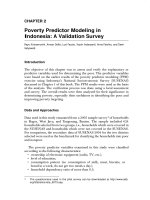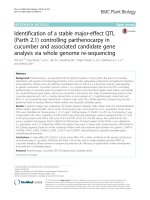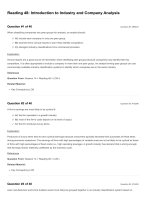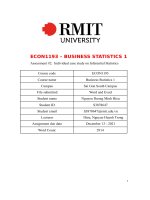Assignment 2 individual essay company analysis MARKS AND SPENCER (ms)
Bạn đang xem bản rút gọn của tài liệu. Xem và tải ngay bản đầy đủ của tài liệu tại đây (314.59 KB, 14 trang )
Assignment 2 - Individual Essay - Company
Analysis
MARKS AND SPENCER
(M&S)
Student Name: Le Minh Hoang Minh
Student Number: s3748986
Word Count: 2471
Table of Contents
I. Introduction
II. Company
overview III. Analysis
● Marks & Spencer CSR work
-
Ethical - philanthropic responsibility
-
Economic Responsibility
-
Legal Responsibility
● Stakeholders partnership
-
Primary stakeholders
-
Secondary stakeholders
IV. Recommendations
V.
Conclusion
VI. References
I) Introduction
Companies in this era of growth are increasingly aware that it is impossible to depend only on
maximizing profits, but the former sub-criterion Corporate Social Responsibility (CSR) also plays an
important role in the long-term development of the company through market orientation and treatment
of stakeholders. CSR can bring reputation and outstanding brand value to companies that use it well,
and customers increasingly pay attention to the health and mental values that evaluate businesses
through the feedback of their customers, employees, communities, and stakeholders so they need to
take it seriously (Grayson D & Hodges A 2017) Marks and Spencer (M&S) company-a leading retailer
is a perfect example of a business that has made a big impact on its CSR plan. In this report, Marks and
Spencer’s CSR activities and further evaluation by practical examples of whether they adhere to the
CSR philosophies outlined in the theory and provide recommendations for the company's CSR
shortcomings.
II) Company overview
Primarily, we must have a better understanding of a company's current situation and background before
evaluating its CSR activities. The Mark and Spencer brand was founded in 1884 by the founders
Michael Marks and Thomas Spencer in the UK and is currently leading the way in one of the largest
retail companies in the world (Sabanoglu T 2019). Besides the main strong products such as food,
household goods, and clothing, M&S is also known for its strong value in convenient transactions,
excellent customer care, good relationship with distributor suppliers and employee protection policy
(Grayson D 2011). However, due to explosive innovations in market speed and competitive pressure
from rivals ( Asiamah F & Ghulam S 2019), it was not until 2003 that M&S really paid attention to
CSR activities (M&S 2003 CSR Report). The company's plan (Alpha plan) consists of five main
categories: environmentally friendly materials, climate, waste, social welfare, and association for longterm development. However, it was not until 2003, due to the explosive innovations in the market
speed and the competition of competitors, the M&S company really paid attention to CSR activities.
The company's plan is set up with 5 main categories: environmentally friendly materials, climate,
waste, social welfare, and association for long term development. Furthermore, in order to enhance
sustainable development and innovation features, M&S has actively discussed and exchanged
knowledge with governmental and non-governmental organizations around the world. By 2020 the
company has achieved significant achievements with its Alpha plan in its sustainable development
goals.
Despite being entangled in a number of gender discrimination cases, M&S's 2025 goal is to
create a deeply bonding relationship with customers, investors, and stakeholders for a
sustainable future of the company ( Jones P & Comfort D 2018).
III)
1.
Analysis
Marks & Spencer CSR work
The concept of the Carroll’s Pyramid is a prime example of businesses contrasting their
sustainability aspects. Carroll's synthesis encompasses the legal, philanthropic, economic,
and ethical aspects of business towards society when combined to create business initiatives
and plans for a partnership with inter-organization concerns ( Baden D 2016 ). Throughout
the case of M&S, the organization focuses primarily on all four fields: ethics/ philanthropic,
economic, and legal thus maintaining ethical enforcement without being compelled.
2. Evaluation
Ethical/philanthropic responsibility
In terms of ethics, what the whole society recognizes is the transcendence of the barrier of normal
economic profit while defining the philanthropic as the goals or activities of the company voluntarily
doing to contribute to the community. Then in 2003, with the help of Schwarts, Carroll developed this
hypothesis into three criteria: conventional, abiotic, and consequentialist. Based on the benefits that
M&S brings to customers and the community in their CSR plans, which are often recognized at the
end of the project, we can consider M&S as a consequentialist type of ethical ( Hoffman W 2001). This
was highlighted in 2003 in the M&S CSR report on the implementation of this concept, with 3 main
mandatory principles in the plan: creating a reasonable working environment, building a perfect
symbiotic relationship with the community, and most importantly creating excellent service and
product quality.
With this principle, the company has been recognized as the company of the year by '' Business
Community '' in 2006 after launching a social experience program to create opportunities for people
of different ages and expertise. These include special circumstances such as homeless
people, people with disabilities getting a job, or the opportunity to return to work. M&S had
in the report the importance of CSR when it was able to attract customers, attract the
attention of potential investors, create profits for shareholders, and recruit quality employees.
In short, if the company applies CSR effectively it not only generates ethical benefits but
also promotes the economy greatly ( Windsor D 2006). Following the success, in 2013 after
setting up the Alpha plan, the company mentioned in the CSR report the upgrade activities.
The company focuses on product development based on sustainable catches such as 100%
fish and wood with 80% recovery. However, they still find it difficult to find distributors
because they are still hesitating with this project. Next, customers tend to spend money on ``
green '' or recyclable products ( N Mohd Suki 2017) and thus the company develops an ecofriendly brand image. That positively affects their fashion items when using environmentally
friendly materials such as polyester, natural silk, organic cotton, and recycled nylon ( Brown
C 2018). The M&S also mentioned the effectiveness of waste prevention and reversing
climate change in its Alpha Plan CSR report: they have reduced construction waste by 50%,
saving 32% of energy consumption and reduced CO2 from the factory by more than 20%.
The company has also developed the production of goods containing high levels of neutral
carbon and in 2012 was the only company to control the idea. The company also attaches
great importance to charitable activities with the environment and people, M&S has
mobilized from the community over 12 years more than 19 million euros for patients with
end-stage breast cancer (Smithers R 2012). Furthermore, they also donated 2.6 million Euro
to Charitable organization Oxfam in 2009. These activities brought customer sympathy,
strengthened relations with the community, and created a very good brand mark, generating
an exponential jump for economic development and profitability.
Economic Responsibility
Positive activities that both indirectly and directly affect the economy of the company are included in
the economic field of sustainable CSR ( Málovics G 2008). Moreover, indirect activities empowering
employees' efforts and enhancing brand value while direct activities focus directly on increasing
interest rates and sales revenue or minimizing litigation risk. Although the activities of the two
economic and ethical sectors often contradict each other when objectively
stated that when investing in CSR-focused market expansion, the company still benefits from the
brand. They also focus on building infrastructure, ensuring a working environment...etc, which is
called ethical. On the other hand, investors and shareholders are mainly interested in profits from
which the business must implement one of two solutions: using cheaper alternative materials or
increasing product prices ( Blanchard O & Rhee C 1993). However, M&S decided to use a sustainable
strategy and raise the brand to the community, and at the same time satisfy both the ethical and
economic fields in an absolute legal manner. As a result, M&S earned 524.2 million euros in profit and
10.5 billion euros in pre-tax revenue in 2019 (M&S Annual Report 2019).
Legal responsibility
M&S has its own legal policy section on the company's website, most of which are based on
UK law and the Consumer Contracts Regulations in 2013, which were updated and
implemented in 2018. Policies designed to protect the interests of customers, avoid misleading
and ensure the transparency of business with customers (M&S, 2018). M&S respects the
privacy of its customers and handles personal data equally and legally. In addition, the
company affirmed that all employees have the right to work legally and enjoy benefits in
accordance with the legal provisions. The employees all claim that they volunteer to work for
the company, not by coercion or illegal forced labour (Corporate Marksandspencer, 2019).
Legal responsibility mainly belongs to state and the enforcement authorities, and after a range
of tests and evaluations, the conclusion is that M&S performs all its activities on a legal basis.
IV) Stakeholders partnership
Before assessing the impact of related party relationships with a company, it is important to
understand the definition and theory of stakeholder impact on company performance. Organizations
or individuals affected or directly affected by the economic and commercial activities of the company,
are known as stakeholders (Jones TM 1995). To achieve sustainable success, company executives
need to align and secure the rights of stakeholders. Especially, M&S is a big company that has
affirmed its brand name and shares bought by many investors, and what they mainly need is profit.
Stakeholders can be divided into two main groups: primary
and secondary, targeted at non-governmental organizations, employees, suppliers, and customers
( Vasi IB & King BG 2012).
1) Primary stakeholders
When compared with the theory of employees' rights and obligations, they are the stakeholders with the
most obvious influence in the company when it comes to directly contribute to the company's
performance, becoming the massive asset of any business company. M&S mentioned that one of their
three principles is to ensure an excellent working environment and facilities for employees. Then,
based on ILO's rights and principles of working for workers and the Universal of United Nations
human rights statement as international standards, the company has created a healthy and safe working
environment. M&S's formar two-year goal is to raise the brand for gender equality protection, two of
their potential strategic programs are 'Emerging Leader' and BSR's Herproject (M&S Alpha Report
2018). Reasonable salary for employees and listening to their opinions is considered an important
criterion of M&S, from which there are regular surveys and consultation organized by the Board of
Directors. Next, the consumer is the element that contributes to the company 's profits and therefore
affects future plans. M&S concentrated on improving after-sales customer support while gathering
feedback from consumers through surveys conducted by the Customer Service department. As
mentioned in the Alpha plan, M&S has allowed customers to '' participate '' in their CSR campaign and
stimulated the customer experience. Under the 18 dietary requirements of the UK Government
Agreement with the Business conference board on Public Health Responsibility, M&S places the
highest emphasis on customer satisfaction and wellbeing while obtaining 100 % organic food without
artificial coloring and preservatives. In addition to increasing the efficiency of CSR, M&S also uses
sustainable materials for its products to protect the environment for its customers. Finally, suppliers are
another reason why businesses must take into account the needs of stakeholders. Selected by the Global
Sourcing Association, M&S has been recognized as one of the top retailers in the world, then suppliers
must not only comply with product quality but must also ensure that the manufacturing process protects
human rights and does not affect the environment. As the M&S’s core principle in the 2003 CSR report
is to produce the highest quality goods, but ethical and non-toxic to the community( M&S CSR Plan
2003). In order to meet the standard,
suppliers must commit to using energy in an economical manner, minimizing the amount
of waste that affects the environment. In addition, M&S also organizes meetings and
seminars to receive and update information on local laws to bring human rights into the
most appropriate policy apparatus.
2) Secondary stakeholders
The definition of secondary stakeholders are the individuals or companies that do not participate in
company activities but are still directly affected ( Clarkson M 1995). The government can be
considered as a primary stakeholder because policies can change a company's situation directly.
Since then, the policies of the British government and the EU Council for business to set goals
to explain and find solutions to environmental and social problems have been established that
by 2032, the world needs to grow 32% more water and double the amount of food and
alternative energy ( Sample I 2009). In the nutritional composition of M&S food products The
amount of salt and sugar, as well as fat, must meet the target of the British Food and Beverage
Federation and the British Retail Association. They must also prove accountability to the UK
Government Department of Public Health. M&S also expresses responsibility for the interests
of secondary stakeholders - in the case of M&S, the non-governmental organizations Oxfam,
WWF, and Green-peace, the company has donated to Oxfam by selling recycled clothing and
has reduced garment waste annually, and the total amount raised is 2.3 million euros. WWF is
also an important partner of M&S and, through the HACCP code of professional conduct, it
ensures the sustainability of fish raw material sources. M&S's project providing facilities for
homeless and disabled children is also supported by their good relationship with UNICEF as £
630,000 has been generated through furniture and clothes hanger recycling.
V) Recommendations
M&S mentioned in its 2025 Alpha plan, with more than 100 commitments in CSR projects to
become the most sustainable retailer in the world, and they are doing really well ( M&S 2025
Plan). However, there are still weaknesses in their plans, especially in terms of conservation,
treatment of animals and talent interaction. The main ingredients of M&S clothing are leather,
fur and cashmere, animal ingredients, the company can organize animal welfare programs ,for
example: giving a customer on an animal farm tour, feeding cows or horses or shearing wool can be a
great idea to connect with customers through CSR. Tesco is a direct competitor of M&S and they are
also famous for their creative and assertive paths that influence the thinking and vision of society.
Moreover, M&S can learn from Tesco community support programs such as seminars to help protect
workers and secure jobs for people are mentioned in the support plan of the program ( Wintour P &
Malik S 2012). Since then, M&S can also organize its own business seminars to retain employees,
recruit more talents and gain social affection.
VI) Conclusion
Through what has been analyzed, we can conclude that the M&S company has been very
successful in applying the CSR plan to the company development program. They have
ensured a balance between economic, ethical and development but still maintained absolute
compliance with the law. In its principles, the company has established sustainable
connections with consumers, employees, nongovernmental organizations, governments and
suppliers. Nevertheless, the organization still needs to solve its animal care shortcomings to
build socio-economic spillovers without unemployment. The company's plan to 2025 will be
successful if they still maintain the values of the culture in the company and develop to the
maximum ability of the employees.
VII) Reference:
Baden D 2016; ‘A reconstruction of Carroll’s pyramid of corporate social responsibility for the
21st century’; International Journal of Corporate Social Responsibility ;1(1), p.8; viewed 15
Aug;
/>
Blanchard O, Rhee C & Summers L 1993; ‘The stock market, profit, and investment’;
The Quarterly Journal of Economics; 108(1); pp.115-136; viewed 15 Aug;
/>
Brown C 2018; ‘How Ethical Is Marks & Spencer?’; Good On You; 18 December; viewed
15 Aug;
/>Clarkson M.E 1995; ‘A stakeholder framework for analyzing and evaluating corporate social
performance’; Academy of management review, vol. 20, no. 1, pp. 92-117; viewed 15 Aug;
Marks and Spencer n.d 2019; ‘ M&S People Principles’;Corporate.marksandspencer.com
;viewed 19 Aug;
/>Grayson D & Hodges A 2017; ‘Corporate social opportunity!: Seven steps to make corporate social
responsibility work for your business’; Routledge; pp.105-139; viewed 15 Aug;
/>nd_Firms_in_the_Global_Economy_an_introduction_into_international_economics_and_busine
ss/links/00b4952ca901531f95000000.pdf#page=114
Hoffman W, Frederick R & Schwartz M 2001; ‘Business Ethics: Readings and Cases
in Corporate Morality’; viewed 16 Aug;
Jones P & Comfort D 2018; ‘ Major European retailers and the circular economy’; Geography;
103, pp.162-166; viewed 16 Aug;
/>
L.pdf#page=52
Jones T.M 1995; ‘Instrumental stakeholder theory: A synthesis of ethics and
economics’; Academy of management review, 20(2), pp.404-437;viewed 16 Aug;
/>
Marksandspencer.com 2018. Help - Legal And Ethical Policies M&S;viewed 16 Aug;
/>Marks and Spencer n.d, ‘Corporate Social Responsibility Report’, company report, Marks and
Spencer, viewed 11 December 2019; viewed 16 Aug;
/>as/marks&spencer.pdf
and
/>
Málovics G, Csigéné N & Kraus S 2008; ‘The role of corporate social responsibility in strong
sustainability’; The Journal of Socio-Economics, 37(3), pp.907-918; viewed 16 Aug; />
Marks and Spencer n.d, ‘Annual Report 2019’, company report, viewed 13 Aug;
/>
Marks and Spencer n.d, ‘Plan A Report 2013’, company report, Marks and Spencer; viewed 19
Aug;
/>Marks and Spencer n.d, ‘Plan A Report 2025’, company report, Marks and Spencer; viewed 19
Aug;
/>Mohd Suki N 2017; ‘Green products usage: structural relationships on customer satisfaction and
loyalty’; International Journal of Sustainable Development & World Ecology, 24(1), pp.88-95;
viewed 19 Aug;
/>
Nyame-Asiamah F & Ghulam S 2019; ‘The relationship between CSR activity and sales growth in the
UK retailing sector’; Social Responsibility Journal; viewed 19 Aug; />output=instlink&q=info:gQihIJcvYFwJ:scholar.google.com/&hl=en&as_sdt=0,5&scillfp=10465
88990557246093&oi=lle
Sabanoglu T 2019; ‘Marks and Spencer - Statistics & Facts’, Statista, 2 July;viewed 19
Aug; />Sample I 2009; ‘World faces 'perfect storm' of problems by 2030, chief scientist to warn’, The
Guardian, 18 March;viewed 20 Aug;
/>
climate
Schwartz M & Carroll A 2003; ‘Corporate Social Responsibility: A Three-Domain
Approach’; Business Ethics Quarterly, 13, 503-530; viewed 20 Aug;
Smithers R 2012; ‘M&S launches 'shwopping' scheme’; The Guardian, 26 April;viewed 20
Aug; />Vasi I.B & King B.G 2012; ‘Social movements, risk perceptions, and economic outcomes: The effect
of primary and secondary stakeholder activism on firms’ perceived environmental risk and financial
performance’; American sociological review, 77(4), pp.573-596;viewed 20 Aug; />
Windsor D 2006; ‘Corporate social responsibility: Three key approaches’; Journal
of management studies, 43(1), pp.93-114;viewed 21 Aug; />
6486.2006.00584.x
Wintour P& Malik S 2012; ‘Tesco offers paid placements and jobs to people on work
experience scheme’; The Guardian, 21 February; viewed 21 Aug;
/>
VIII) Appendix
1) Carroll’s Pyramid of CSR
2) M&S Annual report for 2019









